The M1117 Guardian or "Armored Security Vehicle" (ASV) is an internal security vehicle derived from the Cadillac M706 later marketed as V-100 and V-150 Commando. It was developed in the late 1990s for the US Military Police Corps, first prototypes made by February 1997, production ongoing between 1999 and early 2000. It saw action in Afghanistan and Iraq.
In the years following Vietnam, budget cuts and desilusion led to some questionable choices for the next infantry fighting vehicle, but by the 1980s, U.S. military doctrine renewed its vision of armoured vehicles with Main Battle Tanks assisted by infantry fighting vehicles for frontline combat, unarmored utility vehicles for transport behind lines and nothing in between, which was a cost-saving measure. However all changed in 1993, as combat in Somalia by US forces proved an eye opener.
In Mogadishu, the lightly armoured Humvees proved easy preys and casulaties amounted. This led to the development of up-armored vehicles, a move that was thwarted by generals. However the Military Police Corps stepped in and declared it was interested by this concept to patrol "safe" rear area and insisted to the Army to fund a procurement, whereas asking for a better protected M1114 Humvee as an interim. To gain time, the old V100/150 was chosen as a base for development as a base already well known by the MP.
The first prototypes were developed by the same company as the V100/V150 for added protection and urban combat, by Textron Marine & Land Systems (TM & L) Cadillac Gage. The main design goal was not to carry as many troops as possible but just five fully equipped MPs with full protection against small arms fire, manoeuvrability for urban combat and offering IED/Mine protection. It was notably to be able to get back to base with one shattered roadwheel. The two first prototypes were tested extensively in 1997-98 and many detected issues ironed out. After passing the last official tests, the first M1117 ASV production contract came out, 94 awarded on 30 March 1999 for the US Army Tank-Automotive & Armaments Command (TACOM) in Warren, Michigan for further tests and as en evaluation preserie. Then the rest of the production followed until early 2000, with 1,270 procured by the US Army alone, deployed in Afghanistan and later Iraq. More were procured in the following years.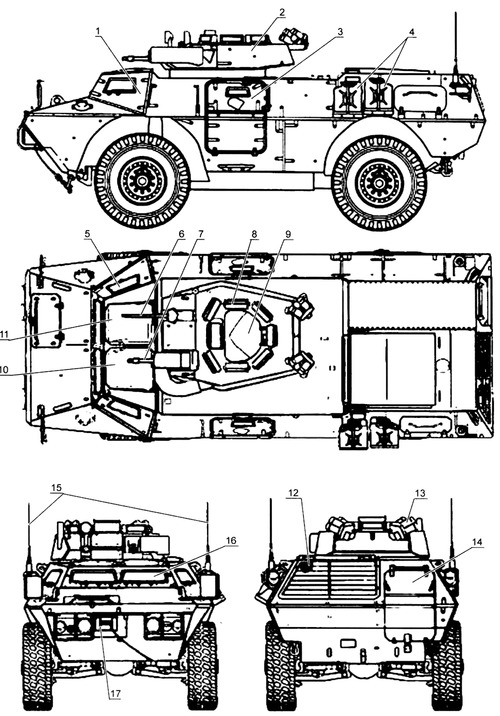
General design of the M1117
The general outlook very much recalled the old CGC M706 of the sixties, with the same, simple flattened lozenge style hull section, a cabin at the front, with however a narrower front cabin, but the same sloped nose design, with the same angles. The vehicle was still relatively narrow, had larger tires than the original while being longer, with a greater wheelbase. The first clue of the new vehicle was a small step behind the driver's cabin, the turret ring with essentially the USMC AAVP-7 amphibious APC turret, and another step aft where the engine was located, on the rear left compartment.
There were six accesses: Two roof hatches over the cabin, two side doors in the hull (upper side, lower down folding halves) with step, as the standard exit/access. There was also the commander's rear-opening circular hatch on top of the turret, which necessitated to climb in, and a rear butterfly door on the back plate, with a narow passage alongside the engine. For the latter, there were several access hatches. The entire roof louvre panel can be removed for field replacement of the whole power unit, as well as the one on the upper back panel, plus a small maintenance and refill hatch located on the left side, folding down. Since this was not an APC, for its size, the vehicle carries a reduced crew of 3, generally a commander, driver, gunner plus one passenger, only if carying a reduced load. On the modified APC variant, this jumps to 11 personal (3+8).
As for vision, both the driver and co-driver has permanent armoured glass windows of reduced size with three wipers each, and fixations to add mesh or extra glass. There is no IR vision system however. The commander/gunner located in the turret has a M36E2 day/night sight with 7x magnification, and a set of six periscopes, three on either side for a peripheric vision on the turret. There are side windows on the cabin and side doors, smaller, with pistol ports but the rear butterfly door is blind. There are two sets of lights, roadlights, blackout and IR lights with brush guards on the nose. Two sets of electic and folding rear mirrors are fitted close to the nose forward also.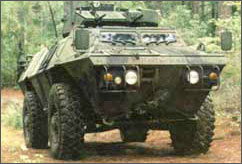 The mission profile leading to its design for mobility required 50% on roads, 30% on secondary roads, 20% off-road, so it was tailored accordingly. The M1117 was powered, in the left rear compartment, by a 260 hp (194 kw) Cummins 6CTA8.3 diesel. It was coupled with an MD3560 automatic Allison Transmission with 6 speed forward and one speed reverse.
The mission profile leading to its design for mobility required 50% on roads, 30% on secondary roads, 20% off-road, so it was tailored accordingly. The M1117 was powered, in the left rear compartment, by a 260 hp (194 kw) Cummins 6CTA8.3 diesel. It was coupled with an MD3560 automatic Allison Transmission with 6 speed forward and one speed reverse.
The vehicle was a full 4x4 with a Front and rear independent suspension and large military grade run-flat tires. It was able to reach 70 mph (110 km/h) on open road, so ideal for rapid transits, down to 60 kph on average between bad roads and on dirt roads and tracks. It was evaluated and capable of fording 5-foot (1.5 m) water, albeit not amphibious, and climb 60% gradient, or negotiate a 30% side slope, as well as climbing a 5 feet step or obstacle. Turning radius was much reduced, at 27.5-foot (8.4 m) while its similar 18-inch (46 cm) ground clearance as the old V100 allowed some leeway off-road.
As for tactical transport, they were narrow enough for six to be stored in single Boeing C-17 Globemaster III airlift aircraft. The Sikorsky CH-53E Super Stallion helicopter could carry one under sling. The base range of the vehicle varies betwene sources, 440 miles (708 km) being the most common on standard roads, based on a fuel Capacity of 50 gallons (189 l metric) using diesel (not multifuel).
The hull angles ware supposed to deflect most RGs (rocket-propelled grenades). A high velocity RPG hit would compromise crew survivability depending on its location. The V-shaped hull underbelly is also efficient against mines and IEDs and ensure crew survivability in most cases. The vehicle is not however protected against ATGMs. The vehicle is also NBC Protected with the M13A1 gas particulate filter system. For active concealment it has two sets of M257 4-tube 66mm smoke grenade launchers, located on either rear corner of the turret, which allows to orientate the launch.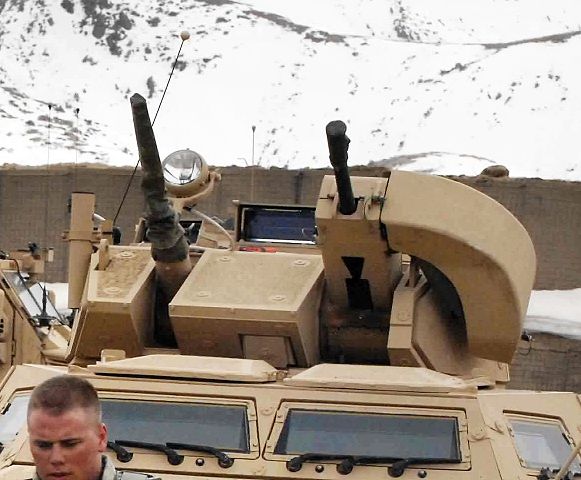
Close view of the turret as high angle elevation, with the M19 mod 3 (right) and M2HB (left). Note the add-one ceramic/composite armour panel on its angular nose, left side projector, radio mast, and M36E2 sight.
As an infantry support capable vehicle, the M1117 is well armed, more versatile than the old CGC which only had a simple one-man turret for a Browning M2HB 0.5 cal. This comprised a twin-part mantle turret with an elevation of 45°. There is on the right a MK19 40mm grenade machine gun, belt feed with 96 ready grenades in a conveyor shaping the right side of the turret with a rounded part. 600 extra grenades are stowed in the hull. The grenade range comprised the HE/DP, HE, TP.
The left side of the turret houses a .50 cal M2HB/M48 machine gun, also belt fed with 200 ready rounds, 800 stowed in cased belts in the hull. It fired a ball tracer round. The vehicle also has a pintle mount for exterior mounting of a M249 GMPG.
Plus the ASV team comprises an additional M249 LMGs, M16/M4 rifles and M203 grenade launcher, but there is enough space inside to carry an AT-4 antitank weapon. Down to the belt-carried regulatory M9 pistols.
It should be noted that the Mk.19 Mod 3 grenade MG could penetrate the armor of most infantry fighting vehicles with the HE/DP round. Typically it was designed to defeat BTR and BMPs at ranges up to 1,000 meters in frontal combat. However in operation, the full belt of 40mm HE/DP was too heavy to be manipulable and replaced by 75 rounds belts instead.
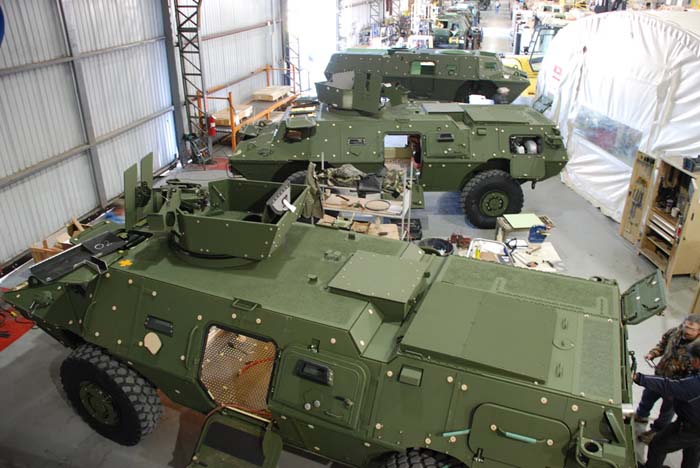
Colombian M1117 ICV in construction at Textron in April 2016. Credits defenseindustrydaily.com src
Textron Systems proposed also the ICV, an Armored Personnel Carrier (APC) variant with a stretched chassis, 24 inches (60 cm) longer compared to the ASV and rearranged to accomodate extra seats, and replacing the turret and its bulky pannier by a simple cupola mounting an M2 pr M19 grenade launcher, for 3 crew and 8 troops. It seems so far only Colombia purchased it, but according to photos, some were donated to the Peshmergas. View of the Iraqi version.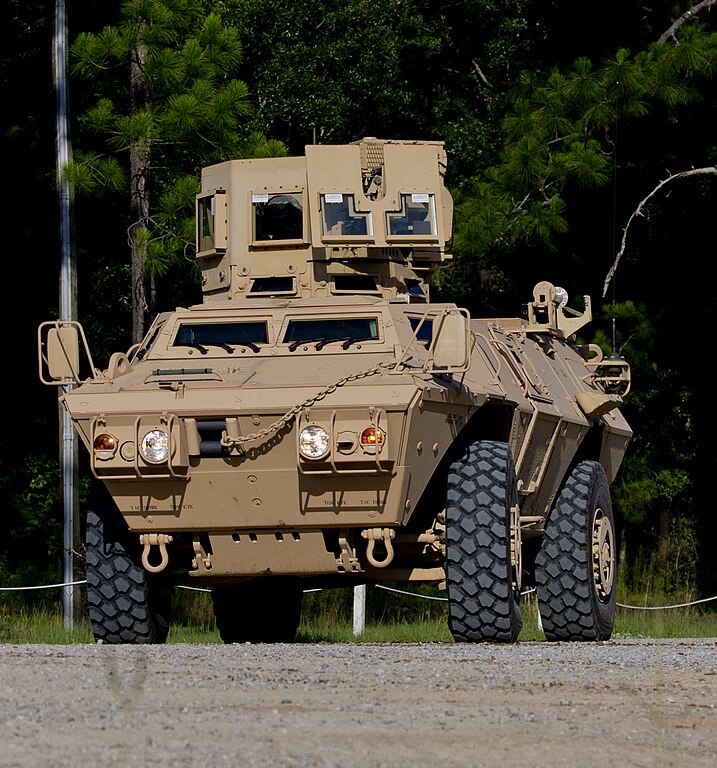
M1200 Armored Knight in Afghanistan
The vehicle was developed from the M1117 following combat experience in Iraq and Afghanistan, but enhanced to be used by forward observers i order to guide precision guided munitions and indirect artillery fire. It combines a laser designator, laser range finder with GPS, radios, computers to manage position data and its transmision to artillery units or bombers overhead.
This whole kit was first used and deployed in operations on the HMMWV stripped down variant called the M707 Knight (replacing the M113 based M981 FISTV). The new vehicle procures this enhanced protection to fire support or Combat Observation and Lasing Teams (COLT). Hence the "armored knight". It had notably a brand new turret made for obervation with extra shielding and powerful sights with laser RF, but is only defended by a M240B or M2 Browning behind a shield. Unit price back in 2008 was 2008. $1,800,000. A fully dedicated article is planned for the future.
The adoption of the M1117 as Mobile Strike Force Vehicle (MSFV) in the new Afghan National Army, reports from their actions against Talibans urged for the adoption of larger caliber weapons and to provide an organic anti-tank/fire support capability. On 22 October 2013 this variant was unveiled by Textron at the annual Association of the United States Army (AUSA) exhibition. Called the "Commando Select 90mm Direct Fire Vehicle" (DFV) was fitted with a much larger turret ring, and accomodating a Cockerill Mk III 90mm low-pressure cannon and its FMI turret.
The wide range of rounds provided still allows to defeat main battle tanks notably by using AFPS. The overall weight rose to 18 metric tonnes (40,000 Ibs). Afghanistan ordered 50 and offered to purchase it through the Foreign Military Sales (FMS) program using US government grants. But since the turrets and guns came from Belgium, the sale had to wait for export documentation to be agree upon.
In 2014, however, the procurement process was suspended, including 300 more MSFVs including the 50 Direct Fire Vehicles under budgetary constraints whereas the US Army still did not finished testing. Albeit Textron officials confered with Afghan authorities in 2017, nothing came up of it. Iraq also requested these DFVs from Textron to deal woth the Islamic State but the sell was blocked by February 2017.

Textron TAPV
The US-built Tactical Armoured Patrol Vehicle followed a development to cover Canadian needs, including a production by the Canadian division of Textron. Development started back in 2009 under the TAPV program until 2012 when the vehicle was accepted and production setup in August 2016. 500 were purchased, 100 more in option. The first demonstration vehicle was unveiled in 2011. Deliveres were completed in 2018. They are replacing the RG-31 Nyala MRAP and Coyote.
Textron Systems Canada Inc., fielded the first batch to the 5th Canadian Division Support Base Gagetown and 2nd Canadian Division Support Base Valcartier. Production plans were 30 vehicles monthly with an initial completion date in December 2017 and 2020 if 100 optional were approved. The vehicles were procured to seven bases and first deployment came by May 2017 with the deployment of the 2nd Canadian Division Valcartier in Operation LENTUS (flooding in Quebec) but no combat deployment so far. This will be treated as a standalone article as well.
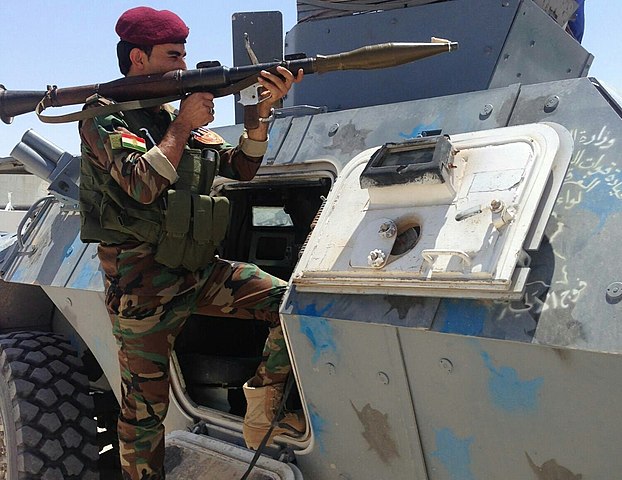
A Peshmerga M1117 ICV in operation (the APV variant).
In 1999, the US Army began started to evaluate a few M1117s for the Military Police Corps, field tested in Kosovo, as part of the 709th MP Battalion. The program was canceled in 2002 due to budget concerns, with the assessment they could be used without an "unacceptable level of risk." It was also expensive at $800,000 apiece by 2011, versus $140,000 for an M1114 or $220,000 for an armoured M1114 Humvee, so large production was still not envisioned when Humvees can be deployed.
The Iraq War start in 2003, with 49 M1117 in service with MP units. The first saw blood with the 527th MP Company and elements of the 720th MP Battalion. Iraq soon proved an ideal ground for the ASV program as HMMWVs proved soon vulnerable to mines, IEDs and casualties amounted fast. Up-armored HMMWVs could only withstand small arms fire but not mines and rockets on the front line and members of Congress visiting Iraq favored the M1117 over other mine protected vehicles.
ASVs in Iraq and Afghanistan withstood several IED attacks indeed, and some vehicles multiple times, with few casualties, and the vehicles were recuperated, repaired and fielded again, unlike most HMMVWs. One ASV for example was hit by an IED which blew all tires, and still managed to make 28 miles (45 km) to its FOB. There also several rollover incidents but the the turret, fully enclosed, protected the gunner and numerous hatches enabled evacuations in all configurations. However two rollovers were fatal, when the turret broke away. Textron added in production 15 additional bolts to the turret for extra security.
By the mid-2000s, production increased 40% due to urgent needs, to 56 vehicles monthly in the New Orleans plant. However the latter was heavily damaged by Hurricane Katrina in August 2005. The facilities were later rebuilt and expanded and by mid-2007, 1,729 vehicles were delivered and fielded to remaining MP units, but also to other military units, and that included the Iraqi National Police.
A Mine Resistant Ambush Protected variant was studied, but in May 2007, it failed ballistics testing at Aberdeen so Textron was told not to receive further orders. Albeit in early 2008, a contract worth $228 million was secured to build 329 ASVs featuring the latest fragmentation protection kit, with a final total of 2,058 vehicles. They soldiered on with far more success compared to the HMMVW and most are still in service in Afghanistan and Iraq today. By April 2019, the M1117 was placed on the Master Divestiture List and the M-ATV was chosen as replacement.
army-technology.com
warwheels.net/
strategypage.com
defenseindustrydaily.com
Full specs http://afvdb.50megs.com
armyrecognition.com
en.topwar.ru
inetres.com
oryxspioenkop.com
The M1117 ASV in training. See also the TAPV
Development
The M1117 was built with a specialized mine-resistant hull, that was one of the prerequisites and something new. It was still not considered as a MRAP, but still adapted to a fluid situation; By 2001 it was adopted to deal with the threat of IEDs. Armament was proven and versatile, with Mk 19 grenade launchers, M2HB Browning machine guns in a tailored turret similar common to USMC Amphibious Assault Vehicles. There was also a M240H Medium Machine Gun outside the gunner's hatch. It was used by the military police, but also convoy escort and more heavily protected than the workhorse, M1114 HMMWV (Humvee) which was not a protected fighting vehicle.Origin and Development
Originally the vehicle was named ASV-150 and designed as a modern take of the old (Vietnam era) Cadillac Gage's V-100 Commando family used by the MP (Military Police). It was frequently used as armed escort for wheeled convoys, when not replaced by improvized "Gun trucks". The USAF also used it to defend airbase perimeters in South Vietnam in the open roof configuration. Needless to say they proved instrumental during the 1969 Tet offensive as rear lines became frontlines. The ASV 150 was designed however with a much improved armor protection and more output for speed and agility, while was the Irish Timoney system of independent suspension adopted for better ride.In the years following Vietnam, budget cuts and desilusion led to some questionable choices for the next infantry fighting vehicle, but by the 1980s, U.S. military doctrine renewed its vision of armoured vehicles with Main Battle Tanks assisted by infantry fighting vehicles for frontline combat, unarmored utility vehicles for transport behind lines and nothing in between, which was a cost-saving measure. However all changed in 1993, as combat in Somalia by US forces proved an eye opener.
In Mogadishu, the lightly armoured Humvees proved easy preys and casulaties amounted. This led to the development of up-armored vehicles, a move that was thwarted by generals. However the Military Police Corps stepped in and declared it was interested by this concept to patrol "safe" rear area and insisted to the Army to fund a procurement, whereas asking for a better protected M1114 Humvee as an interim. To gain time, the old V100/150 was chosen as a base for development as a base already well known by the MP.
The first prototypes were developed by the same company as the V100/V150 for added protection and urban combat, by Textron Marine & Land Systems (TM & L) Cadillac Gage. The main design goal was not to carry as many troops as possible but just five fully equipped MPs with full protection against small arms fire, manoeuvrability for urban combat and offering IED/Mine protection. It was notably to be able to get back to base with one shattered roadwheel. The two first prototypes were tested extensively in 1997-98 and many detected issues ironed out. After passing the last official tests, the first M1117 ASV production contract came out, 94 awarded on 30 March 1999 for the US Army Tank-Automotive & Armaments Command (TACOM) in Warren, Michigan for further tests and as en evaluation preserie. Then the rest of the production followed until early 2000, with 1,270 procured by the US Army alone, deployed in Afghanistan and later Iraq. More were procured in the following years.
Design
The M1117 is slightly larger than the old CGC M706, 20.5 ft (6.25 m) in lenght for 8.42 ft (2.57 m) in width overall, 8.5 ft (2.59 m) at the turret top and 6.75 ft (2.06 m) at hull top, with a ground Clearance of 18 in (457 mm) and 14.78 tons (13.41 mt) in combat order.Hull and General Layout

General design of the M1117
The general outlook very much recalled the old CGC M706 of the sixties, with the same, simple flattened lozenge style hull section, a cabin at the front, with however a narrower front cabin, but the same sloped nose design, with the same angles. The vehicle was still relatively narrow, had larger tires than the original while being longer, with a greater wheelbase. The first clue of the new vehicle was a small step behind the driver's cabin, the turret ring with essentially the USMC AAVP-7 amphibious APC turret, and another step aft where the engine was located, on the rear left compartment.
There were six accesses: Two roof hatches over the cabin, two side doors in the hull (upper side, lower down folding halves) with step, as the standard exit/access. There was also the commander's rear-opening circular hatch on top of the turret, which necessitated to climb in, and a rear butterfly door on the back plate, with a narow passage alongside the engine. For the latter, there were several access hatches. The entire roof louvre panel can be removed for field replacement of the whole power unit, as well as the one on the upper back panel, plus a small maintenance and refill hatch located on the left side, folding down. Since this was not an APC, for its size, the vehicle carries a reduced crew of 3, generally a commander, driver, gunner plus one passenger, only if carying a reduced load. On the modified APC variant, this jumps to 11 personal (3+8).
As for vision, both the driver and co-driver has permanent armoured glass windows of reduced size with three wipers each, and fixations to add mesh or extra glass. There is no IR vision system however. The commander/gunner located in the turret has a M36E2 day/night sight with 7x magnification, and a set of six periscopes, three on either side for a peripheric vision on the turret. There are side windows on the cabin and side doors, smaller, with pistol ports but the rear butterfly door is blind. There are two sets of lights, roadlights, blackout and IR lights with brush guards on the nose. Two sets of electic and folding rear mirrors are fitted close to the nose forward also.
Power Plant and Performances
 The mission profile leading to its design for mobility required 50% on roads, 30% on secondary roads, 20% off-road, so it was tailored accordingly. The M1117 was powered, in the left rear compartment, by a 260 hp (194 kw) Cummins 6CTA8.3 diesel. It was coupled with an MD3560 automatic Allison Transmission with 6 speed forward and one speed reverse.
The mission profile leading to its design for mobility required 50% on roads, 30% on secondary roads, 20% off-road, so it was tailored accordingly. The M1117 was powered, in the left rear compartment, by a 260 hp (194 kw) Cummins 6CTA8.3 diesel. It was coupled with an MD3560 automatic Allison Transmission with 6 speed forward and one speed reverse.
The vehicle was a full 4x4 with a Front and rear independent suspension and large military grade run-flat tires. It was able to reach 70 mph (110 km/h) on open road, so ideal for rapid transits, down to 60 kph on average between bad roads and on dirt roads and tracks. It was evaluated and capable of fording 5-foot (1.5 m) water, albeit not amphibious, and climb 60% gradient, or negotiate a 30% side slope, as well as climbing a 5 feet step or obstacle. Turning radius was much reduced, at 27.5-foot (8.4 m) while its similar 18-inch (46 cm) ground clearance as the old V100 allowed some leeway off-road.
As for tactical transport, they were narrow enough for six to be stored in single Boeing C-17 Globemaster III airlift aircraft. The Sikorsky CH-53E Super Stallion helicopter could carry one under sling. The base range of the vehicle varies betwene sources, 440 miles (708 km) being the most common on standard roads, based on a fuel Capacity of 50 gallons (189 l metric) using diesel (not multifuel).
Armour Protection
The ASV uses a new type of advanced, modular expandable armor package. It was designed and procured by IBD Deisenroth Engineering. The concept was to add ceramic composite applique panels bolted on the exterior of the steel RHA hull, plus a spall liner interior to deal with shrapnel. Given its priority task, the vehicle is immune at all angles against small arms fire, up to 9 mm AP rounds, but also mines and Improvised Explosive Devices (IEDs). With combat experience, ASV Frag Kits 1 and 2 were sent to be installed, helping with modern RPGs that were used. 850 of both were procured FY2008.The hull angles ware supposed to deflect most RGs (rocket-propelled grenades). A high velocity RPG hit would compromise crew survivability depending on its location. The V-shaped hull underbelly is also efficient against mines and IEDs and ensure crew survivability in most cases. The vehicle is not however protected against ATGMs. The vehicle is also NBC Protected with the M13A1 gas particulate filter system. For active concealment it has two sets of M257 4-tube 66mm smoke grenade launchers, located on either rear corner of the turret, which allows to orientate the launch.
Armament

Close view of the turret as high angle elevation, with the M19 mod 3 (right) and M2HB (left). Note the add-one ceramic/composite armour panel on its angular nose, left side projector, radio mast, and M36E2 sight.
As an infantry support capable vehicle, the M1117 is well armed, more versatile than the old CGC which only had a simple one-man turret for a Browning M2HB 0.5 cal. This comprised a twin-part mantle turret with an elevation of 45°. There is on the right a MK19 40mm grenade machine gun, belt feed with 96 ready grenades in a conveyor shaping the right side of the turret with a rounded part. 600 extra grenades are stowed in the hull. The grenade range comprised the HE/DP, HE, TP.
The left side of the turret houses a .50 cal M2HB/M48 machine gun, also belt fed with 200 ready rounds, 800 stowed in cased belts in the hull. It fired a ball tracer round. The vehicle also has a pintle mount for exterior mounting of a M249 GMPG.
Plus the ASV team comprises an additional M249 LMGs, M16/M4 rifles and M203 grenade launcher, but there is enough space inside to carry an AT-4 antitank weapon. Down to the belt-carried regulatory M9 pistols.
It should be noted that the Mk.19 Mod 3 grenade MG could penetrate the armor of most infantry fighting vehicles with the HE/DP round. Typically it was designed to defeat BTR and BMPs at ranges up to 1,000 meters in frontal combat. However in operation, the full belt of 40mm HE/DP was too heavy to be manipulable and replaced by 75 rounds belts instead.
Variants
- Command & Control
- Recovery Vehicle (Each ASV can flat tow another ASV or HMMWV)
- Reconnaissance Surveillance & Target Acquisition (RSTA)
- Ambulance
- Infantry Carrier Vehicle
- M1200 Armored Knight FiST-V
ICV (Infantry Combat Vehicle)

Colombian M1117 ICV in construction at Textron in April 2016. Credits defenseindustrydaily.com src
Textron Systems proposed also the ICV, an Armored Personnel Carrier (APC) variant with a stretched chassis, 24 inches (60 cm) longer compared to the ASV and rearranged to accomodate extra seats, and replacing the turret and its bulky pannier by a simple cupola mounting an M2 pr M19 grenade launcher, for 3 crew and 8 troops. It seems so far only Colombia purchased it, but according to photos, some were donated to the Peshmergas. View of the Iraqi version.
M1200 Armored Knight FiST-V

M1200 Armored Knight in Afghanistan
The vehicle was developed from the M1117 following combat experience in Iraq and Afghanistan, but enhanced to be used by forward observers i order to guide precision guided munitions and indirect artillery fire. It combines a laser designator, laser range finder with GPS, radios, computers to manage position data and its transmision to artillery units or bombers overhead.
This whole kit was first used and deployed in operations on the HMMWV stripped down variant called the M707 Knight (replacing the M113 based M981 FISTV). The new vehicle procures this enhanced protection to fire support or Combat Observation and Lasing Teams (COLT). Hence the "armored knight". It had notably a brand new turret made for obervation with extra shielding and powerful sights with laser RF, but is only defended by a M240B or M2 Browning behind a shield. Unit price back in 2008 was 2008. $1,800,000. A fully dedicated article is planned for the future.
MSFV and Direct Fire Vehicle (2013)

The adoption of the M1117 as Mobile Strike Force Vehicle (MSFV) in the new Afghan National Army, reports from their actions against Talibans urged for the adoption of larger caliber weapons and to provide an organic anti-tank/fire support capability. On 22 October 2013 this variant was unveiled by Textron at the annual Association of the United States Army (AUSA) exhibition. Called the "Commando Select 90mm Direct Fire Vehicle" (DFV) was fitted with a much larger turret ring, and accomodating a Cockerill Mk III 90mm low-pressure cannon and its FMI turret.
The wide range of rounds provided still allows to defeat main battle tanks notably by using AFPS. The overall weight rose to 18 metric tonnes (40,000 Ibs). Afghanistan ordered 50 and offered to purchase it through the Foreign Military Sales (FMS) program using US government grants. But since the turrets and guns came from Belgium, the sale had to wait for export documentation to be agree upon.
In 2014, however, the procurement process was suspended, including 300 more MSFVs including the 50 Direct Fire Vehicles under budgetary constraints whereas the US Army still did not finished testing. Albeit Textron officials confered with Afghan authorities in 2017, nothing came up of it. Iraq also requested these DFVs from Textron to deal woth the Islamic State but the sell was blocked by February 2017.
Textron TAPV


Textron TAPV
The US-built Tactical Armoured Patrol Vehicle followed a development to cover Canadian needs, including a production by the Canadian division of Textron. Development started back in 2009 under the TAPV program until 2012 when the vehicle was accepted and production setup in August 2016. 500 were purchased, 100 more in option. The first demonstration vehicle was unveiled in 2011. Deliveres were completed in 2018. They are replacing the RG-31 Nyala MRAP and Coyote.
Textron Systems Canada Inc., fielded the first batch to the 5th Canadian Division Support Base Gagetown and 2nd Canadian Division Support Base Valcartier. Production plans were 30 vehicles monthly with an initial completion date in December 2017 and 2020 if 100 optional were approved. The vehicles were procured to seven bases and first deployment came by May 2017 with the deployment of the 2nd Canadian Division Valcartier in Operation LENTUS (flooding in Quebec) but no combat deployment so far. This will be treated as a standalone article as well.
Export
- Afghanistan c50+ captured by the Taliban in 2021
- Bulgaria 37 ordered, ordered 2008. NSVT HMG instead of M2
- Canada: 500 Textron Tactical Armoured Patrol Vehicles
- Colombia: 39, then 39 in 2012. August 2020, donation of 200 approved under EDA
- Greece: 837 (363 delivered uner EDA program)
- Iraq 264 (60 more ordered April 2016) Iraqi National Police
- Former Islamic Republic of Afghanistan: 634
- Kosovo: 55 by the KSF, donated and purchased.
- USA: 1,836. Mostly U.S. Army military police units
- Ukraine: 250 pledged by November 2022, none delivered.
| Dimensions (L-w-H) | 237 x 101 x 102 inches (6 x 2.6 x 2.6 m) |
| Full weight | 29,560 lb (13,410 kg) |
| Crew | 5: driver, 4 troopers |
| Propulsion | Cummins 6CTA8.3 260 hp, 828 ft/ib torque |
| Transmission | MD3560 6-speed Allison |
| Top speed | 63 mph (101 km/h) |
| Suspensions | 4×4 wheeled, fully independent |
| Range (Fuel) | 475 miles/50 mph |
| Armament | 40 mm Mk 19 grenade launcher, .50 caliber M2HB HMG, M240H GMPG |
| Armor | IBD Modular Expandable Armor System |
| Production | 2058 |
The M1117 ASV in action

A Peshmerga M1117 ICV in operation (the APV variant).
In 1999, the US Army began started to evaluate a few M1117s for the Military Police Corps, field tested in Kosovo, as part of the 709th MP Battalion. The program was canceled in 2002 due to budget concerns, with the assessment they could be used without an "unacceptable level of risk." It was also expensive at $800,000 apiece by 2011, versus $140,000 for an M1114 or $220,000 for an armoured M1114 Humvee, so large production was still not envisioned when Humvees can be deployed.
The Iraq War start in 2003, with 49 M1117 in service with MP units. The first saw blood with the 527th MP Company and elements of the 720th MP Battalion. Iraq soon proved an ideal ground for the ASV program as HMMWVs proved soon vulnerable to mines, IEDs and casualties amounted fast. Up-armored HMMWVs could only withstand small arms fire but not mines and rockets on the front line and members of Congress visiting Iraq favored the M1117 over other mine protected vehicles.
ASVs in Iraq and Afghanistan withstood several IED attacks indeed, and some vehicles multiple times, with few casualties, and the vehicles were recuperated, repaired and fielded again, unlike most HMMVWs. One ASV for example was hit by an IED which blew all tires, and still managed to make 28 miles (45 km) to its FOB. There also several rollover incidents but the the turret, fully enclosed, protected the gunner and numerous hatches enabled evacuations in all configurations. However two rollovers were fatal, when the turret broke away. Textron added in production 15 additional bolts to the turret for extra security.
By the mid-2000s, production increased 40% due to urgent needs, to 56 vehicles monthly in the New Orleans plant. However the latter was heavily damaged by Hurricane Katrina in August 2005. The facilities were later rebuilt and expanded and by mid-2007, 1,729 vehicles were delivered and fielded to remaining MP units, but also to other military units, and that included the Iraqi National Police.
A Mine Resistant Ambush Protected variant was studied, but in May 2007, it failed ballistics testing at Aberdeen so Textron was told not to receive further orders. Albeit in early 2008, a contract worth $228 million was secured to build 329 ASVs featuring the latest fragmentation protection kit, with a final total of 2,058 vehicles. They soldiered on with far more success compared to the HMMVW and most are still in service in Afghanistan and Iraq today. By April 2019, the M1117 was placed on the Master Divestiture List and the M-ATV was chosen as replacement.
& resources
military.com/army-technology.com
warwheels.net/
strategypage.com
defenseindustrydaily.com
Full specs http://afvdb.50megs.com
armyrecognition.com
en.topwar.ru
inetres.com
oryxspioenkop.com
Videos
The M1117 ASV in training. See also the TAPV
Gallery
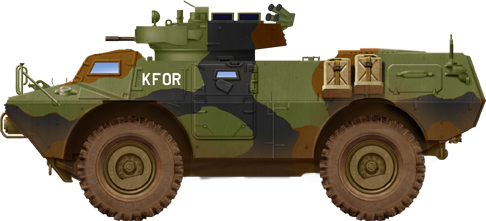
ASV MP in Kosovo 2001
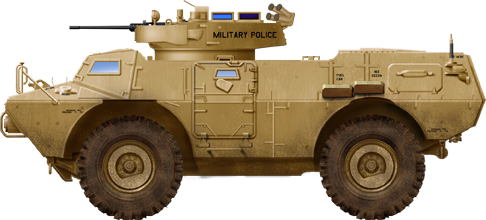
M1117 of the Military Police 527th in Iraq, 2003
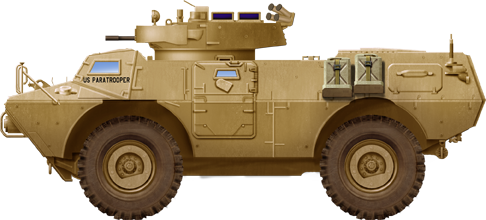
Vehicle of the 42th Bridade Paratrooopers in Iraq, 2005
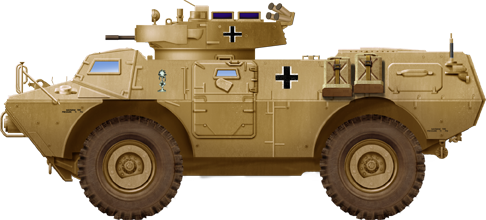
M1117 of the 221st Cav. "DAK" Iraq Echelon
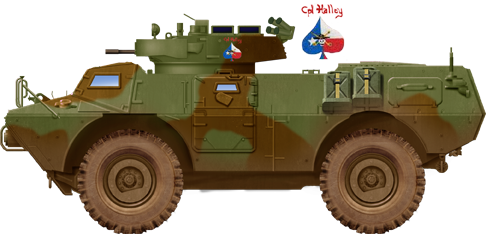
M1117 of the 124th Cav. in Iraq
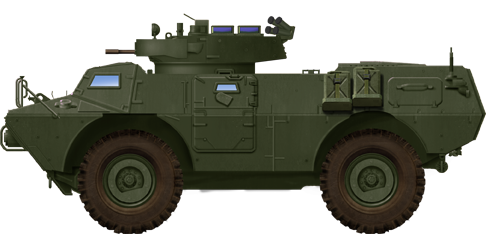
Bulgarian ASV today
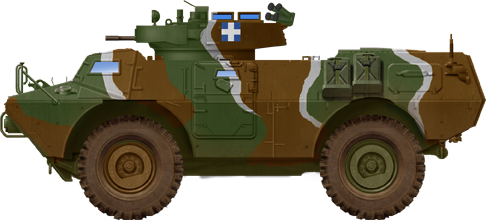
Greek M1117
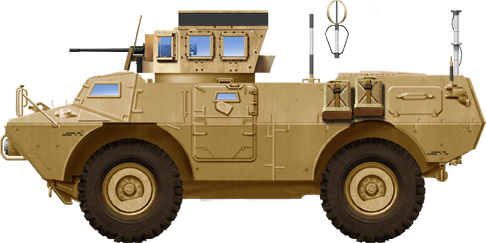
Afghan Mobile Strike Force Vehicle Program, 2020
(To come: Bolivian M1117 ICV)
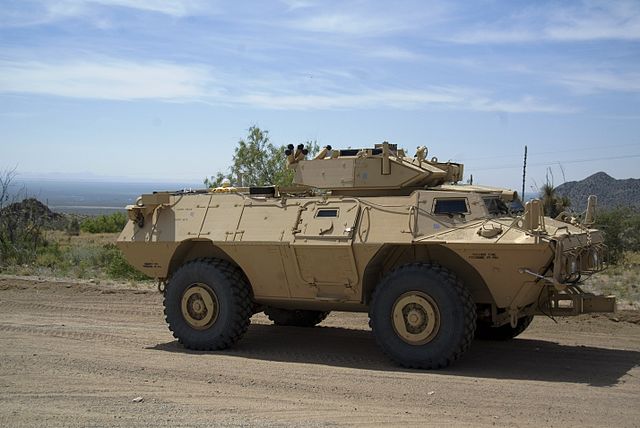
M1117 Guardian Armored Security Vehicle

M1117 damaged by a IED
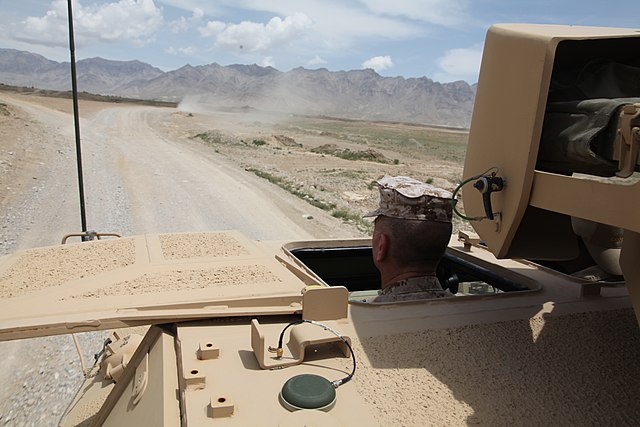
M1117 driver hatch
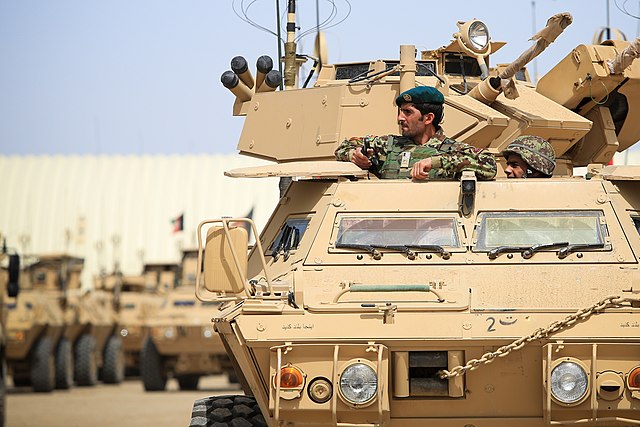
M1117 Camp Shorabak Helmand Province Afghanistan March 19 2014
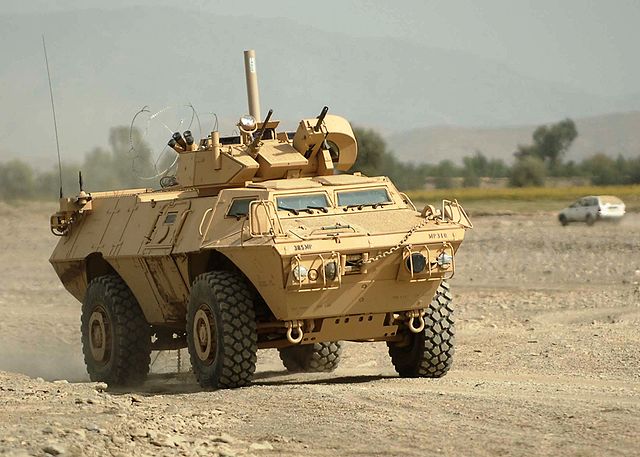
M1117 ASV
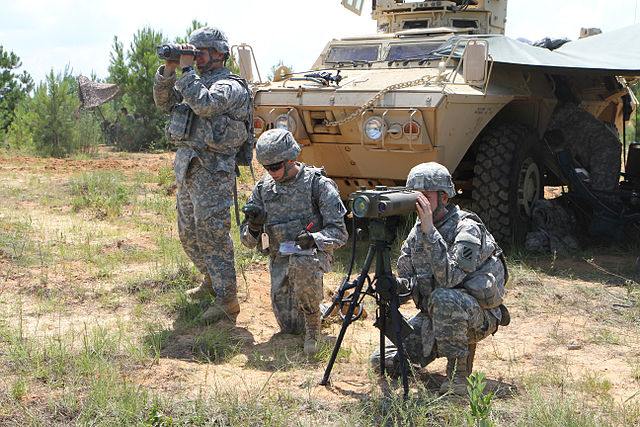
FA turns up the heat in Artillery Table VI training

At Fort Irwin National Training Center
Bulgarian M1117
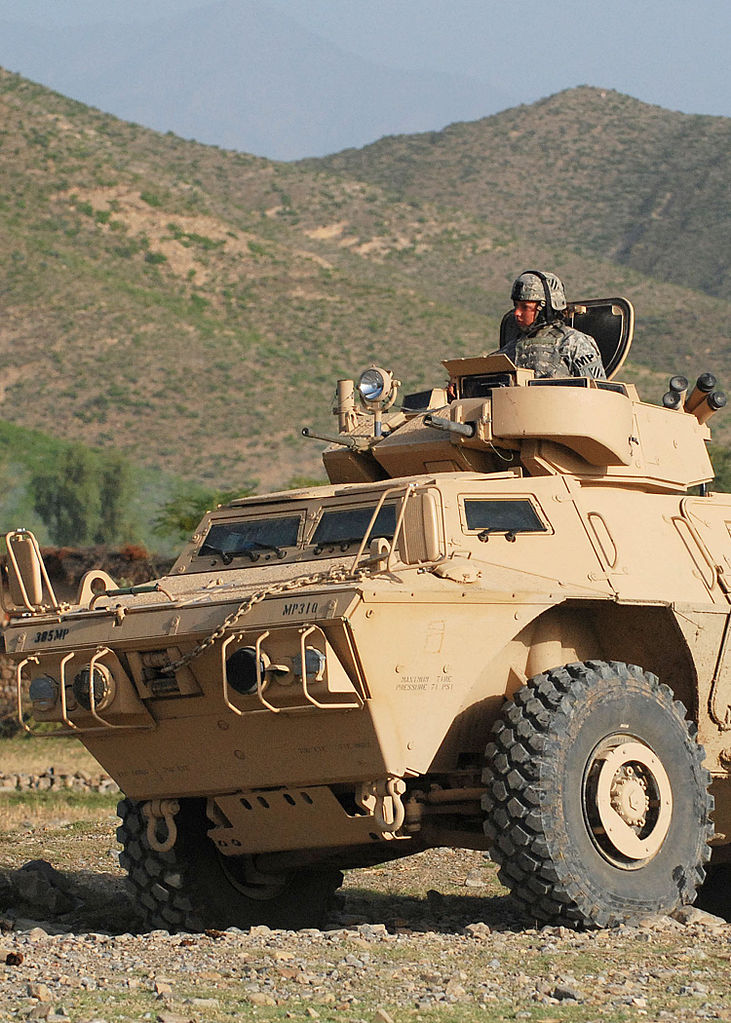
3rd Platoon 546th Company 385th Military Police Battalion 3rd Infantry Division
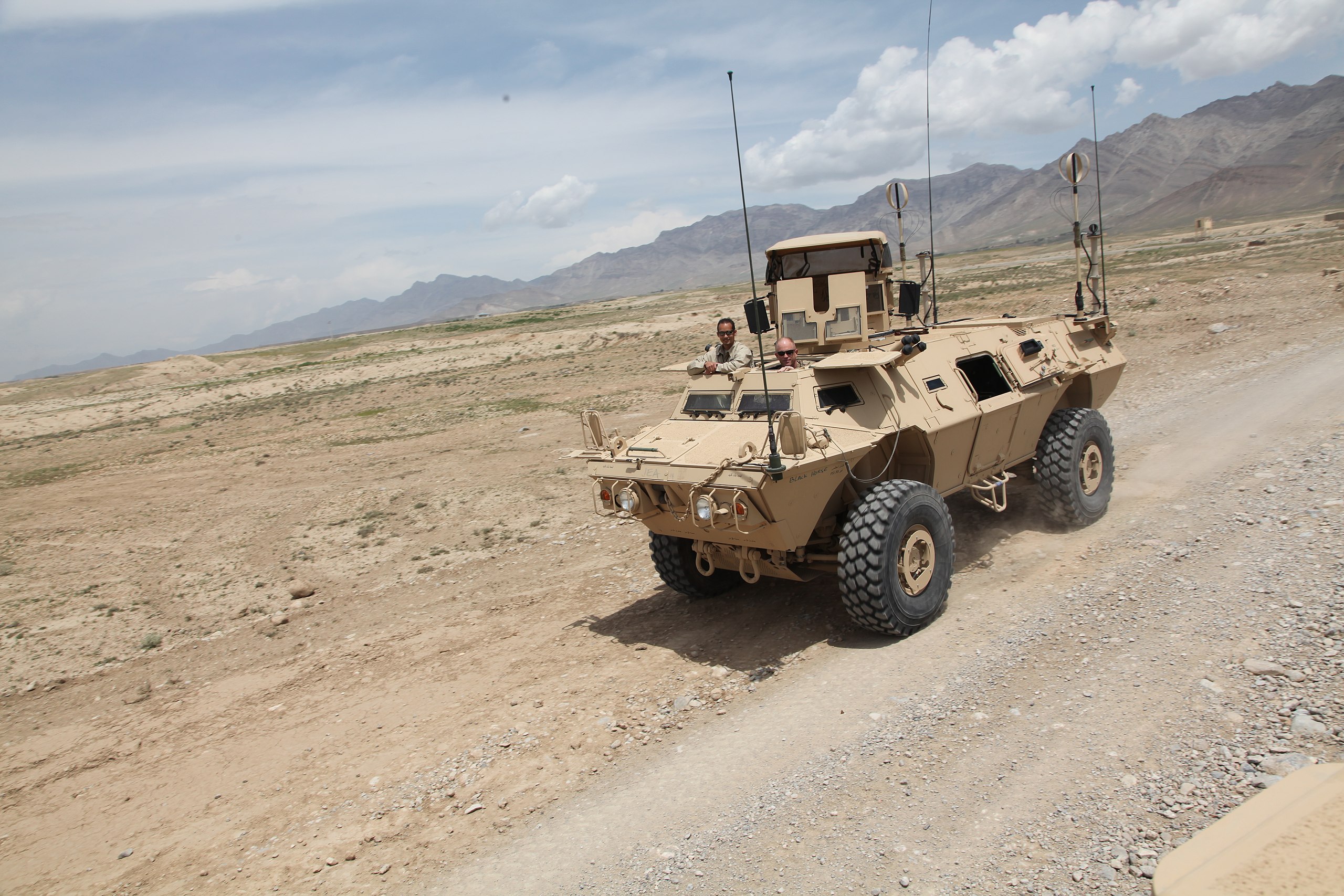
US Air Force 9th Air and Space Expeditionary Task Force Afghanistan ASV
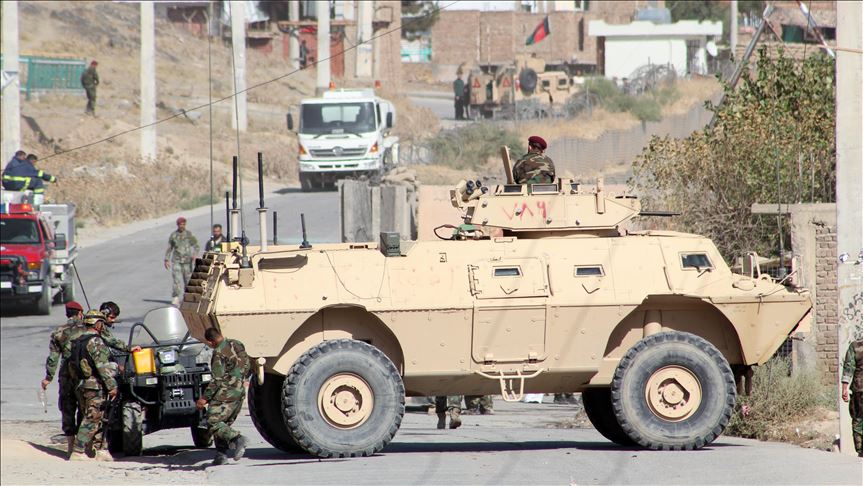
Afghan Police Vehicle


Modern Tanks
Modern MBTs posters

Denel Bagder (2018)

Type 16 MCV (2016)

Gepard 1A2 last rounds 2011

SANDF

Russian AFVs

Main Battle Tanks
